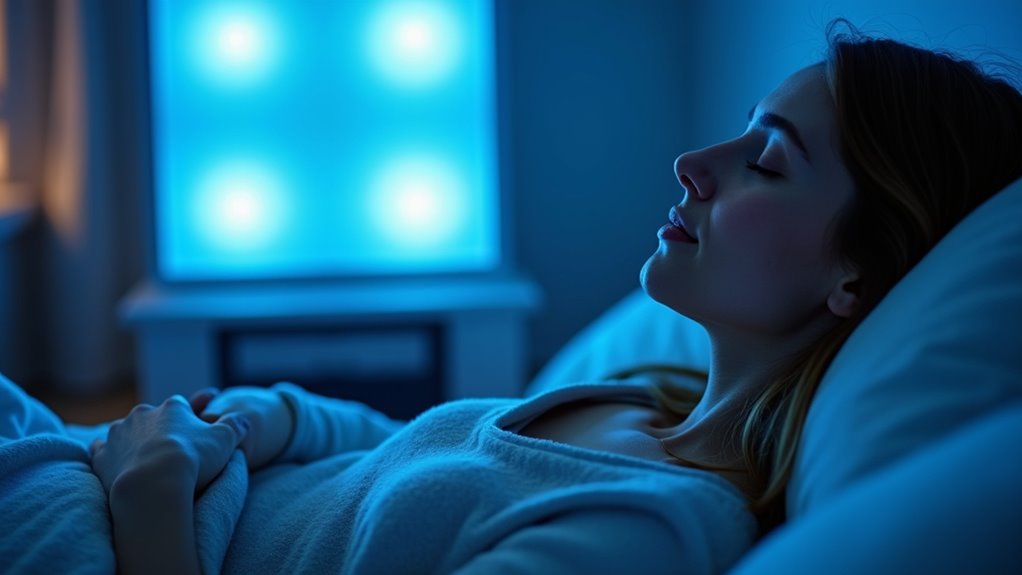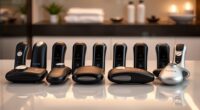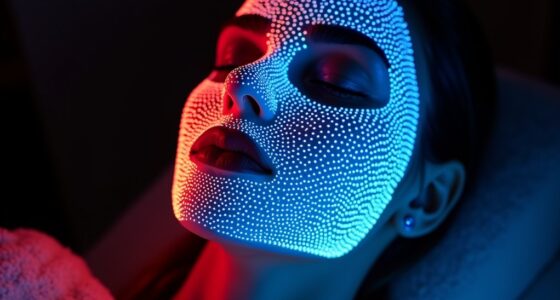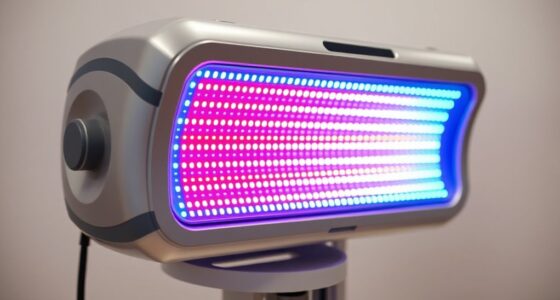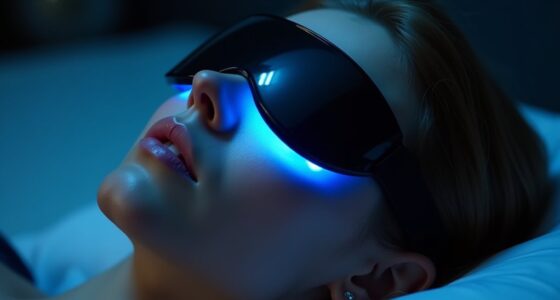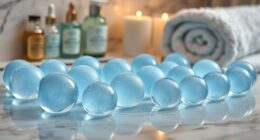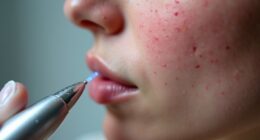LED therapy can markedly boost your mood if you have Seasonal Affective Disorder by mimicking sunlight to regulate your internal clock and increase mood chemicals like serotonin. It resets your circadian rhythms, helping improve sleep and emotional stability. Using the right device and following proper protocols makes a real difference. To discover how these treatments work and how to use them safely, keep exploring the science behind LED light therapy and its benefits.
Key Takeaways
- LED light therapy mimics natural sunlight to regulate circadian rhythms and boost mood-related brain chemicals like serotonin.
- Properly timed sessions with high-intensity LED lights can significantly reduce seasonal depression symptoms.
- Blue-enriched LED spectra are especially effective in improving mood and stabilizing sleep patterns.
- Consistent use and correct device settings enhance therapy effectiveness and minimize side effects like eye strain.
- Combining LED therapy with lifestyle strategies boosts overall mood improvement and supports long-term mental health.
How Does LED Light Therapy Work to Improve Mood?
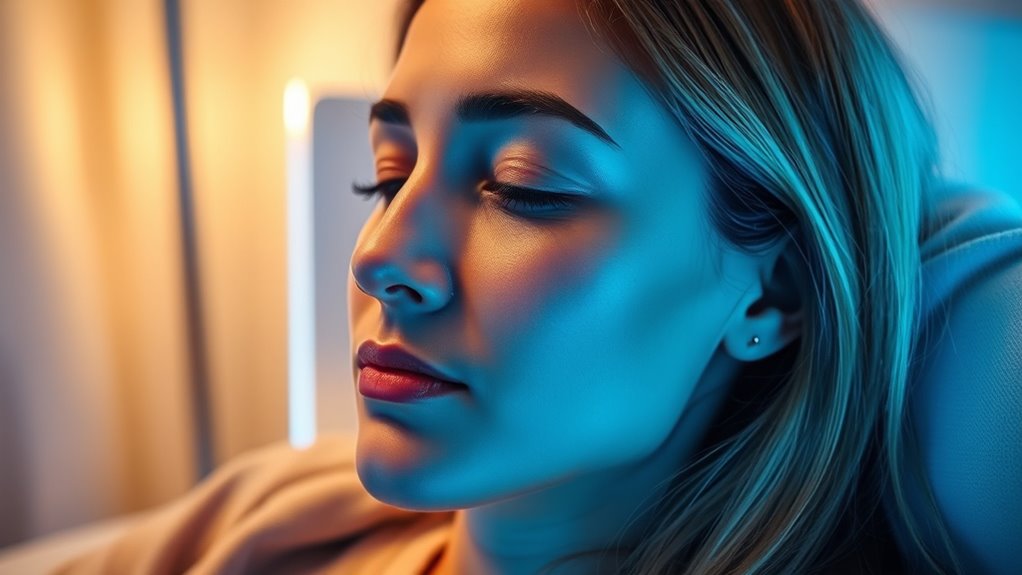
LED light therapy works by exposing you to a specific type of bright light that mimics natural sunlight, which can help regulate your body’s internal clock. This light exposure triggers phototherapy benefits by influencing your brain’s production of mood-regulating chemicals like serotonin. When you receive the right amount of light, it signals your brain that it’s daytime, helping to reset your circadian rhythms and improve your sleep patterns. Better sleep and stabilized biological clocks can decrease feelings of depression commonly linked to Seasonal Affective Disorder. The light used in LED therapy is designed to be safe and effective, providing consistent phototherapy benefits without harmful UV rays. Overall, this targeted light exposure can markedly lift your mood and boost your overall well-being. Incorporating AI-driven insights can further personalize your therapy sessions for optimal results.
Comparing LED Therapy With Traditional Bright Light Therapy
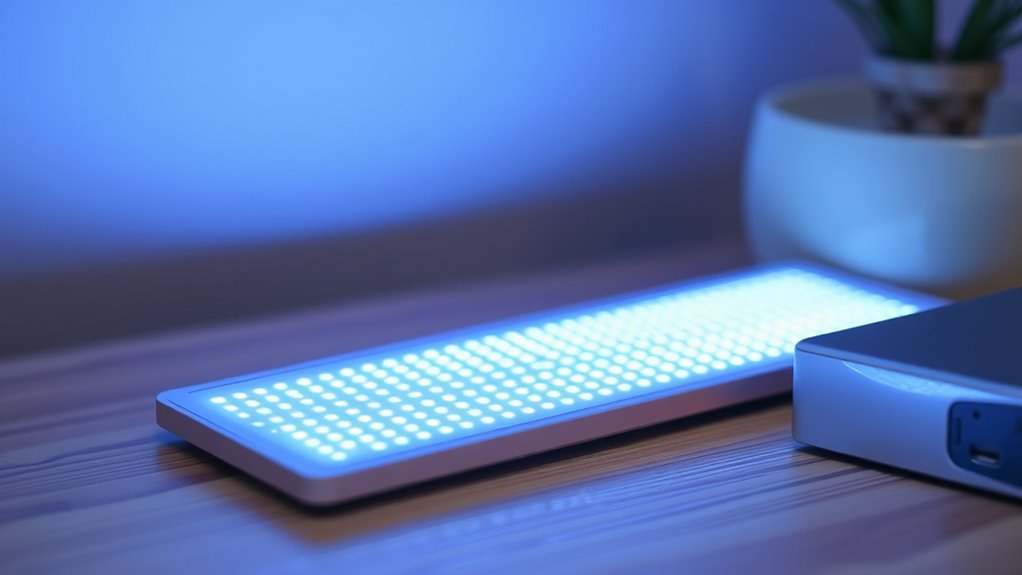
While traditional bright light therapy has been a standard treatment for Seasonal Affective Disorder for years, LED therapy offers several notable advantages. One key benefit is the variety of light colors available, allowing you to customize the treatment to your needs. Unlike traditional lamps, LED devices are often more portable, so you can easily carry them to work or during travel, making consistent use more convenient. LED lights also tend to have a longer lifespan and use less energy, reducing ongoing costs. While both methods aim to regulate your circadian rhythms, LED therapy’s flexibility in light color and compact design can enhance your overall experience. These features make LED therapy a practical and adaptable alternative to traditional bright light therapy.
The Science Behind Light and Mood Regulation
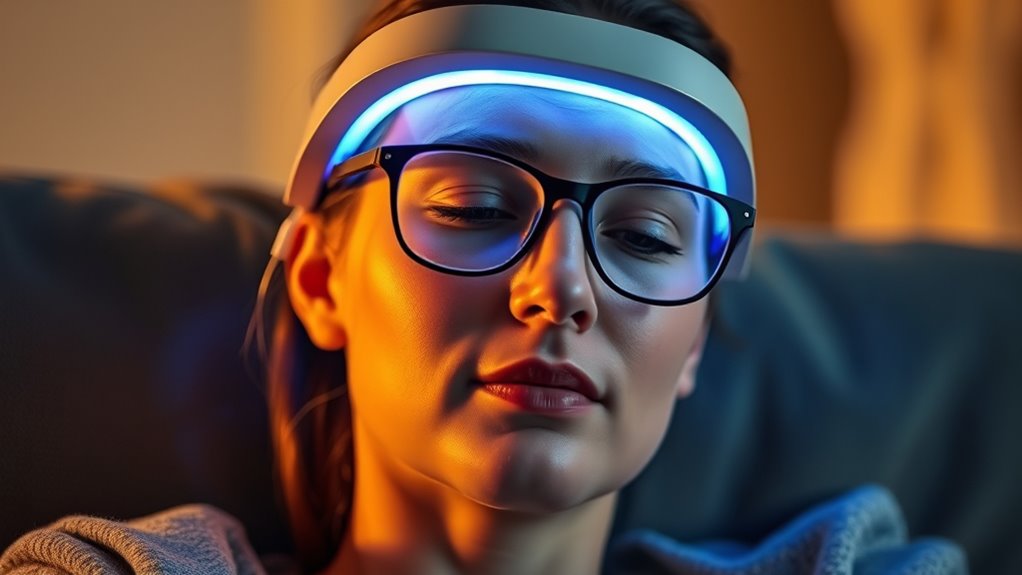
Light influences your mood by interacting with your body’s internal clock, or circadian rhythms, which control sleep, alertness, and emotional health. Exposure to natural or artificial light helps synchronize these rhythms, ensuring your body’s processes run smoothly. When light levels drop, especially during winter, your circadian rhythms can become disrupted, affecting melatonin regulation. Melatonin, a hormone that promotes sleep, is produced in response to darkness. Too much or too little light can throw off melatonin levels, leading to symptoms like fatigue, mood swings, and depression. Proper light exposure, such as through LED therapy, helps reset your circadian rhythms, normalizes melatonin regulation, and supports a balanced mood. Additionally, understanding the chemical properties of light allows for more targeted and effective light therapies. This connection highlights how light therapy can influence your emotional well-being.
What Research Says About the Effectiveness of LED Therapy for SAD
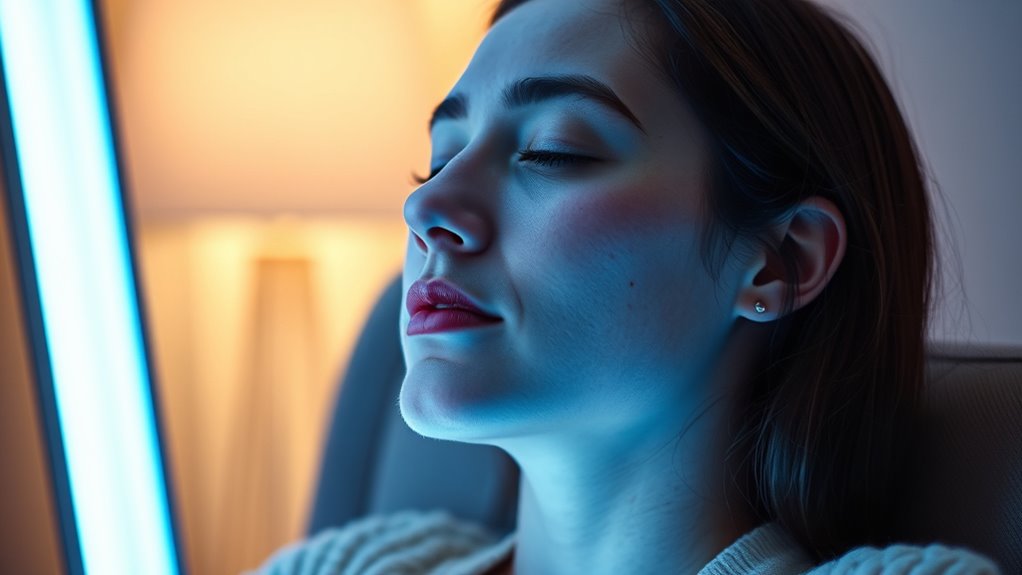
Research has consistently shown that LED therapy can be an effective treatment for Seasonal Affective Disorder. Studies indicate that exposure to specific light spectrum wavelengths, especially blue-enriched light, can markedly improve mood enhancement. LED devices deliver targeted light that mimics natural sunlight, which helps regulate your circadian rhythm and boost serotonin levels. Many clinical trials report notable reductions in SAD symptoms after just a few sessions per week. The evidence suggests that consistent use of LED therapy can lift your spirits and reduce feelings of depression during the darker months. Additionally, remote hackathons demonstrate how digital platforms can facilitate collaboration and innovation in health tech solutions, including treatments like LED therapy. While individual responses vary, the growing body of research supports LED therapy as a safe, non-invasive option for managing seasonal mood changes effectively.
Types of LED Devices Available and How to Choose One
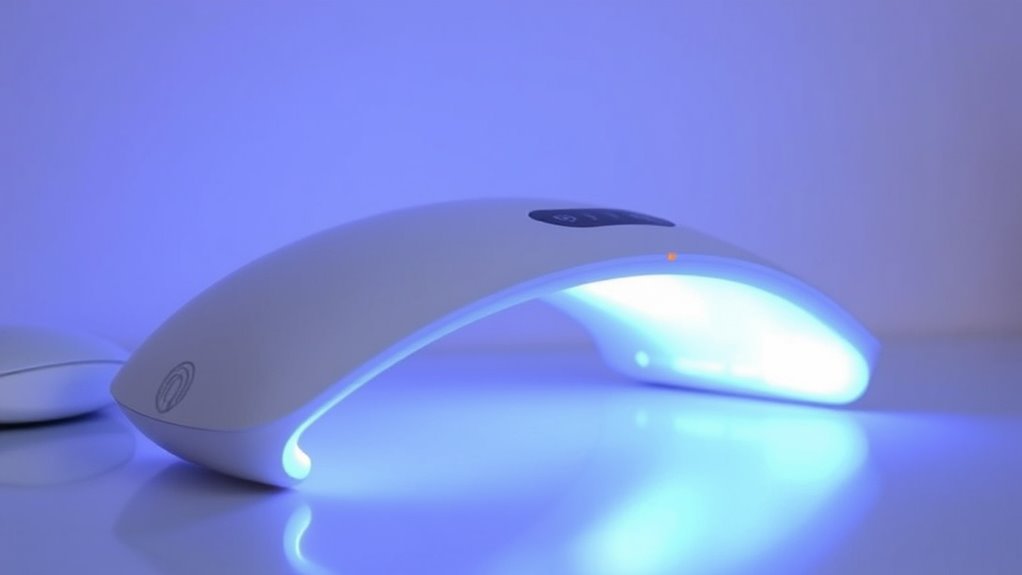
There are different types of LED devices designed for SAD, each with unique features to suit your needs. When choosing one, you’ll want to contemplate factors like light intensity, size, and ease of use. Knowing what to look for helps you select the best device to effectively manage your symptoms. Additionally, understanding forsale 100 options can help you find quality devices at competitive prices.
Device Types and Features
When selecting an LED device for treating seasonal affective disorder, understanding the different types and features available can help you make an informed choice. You’ll find devices with varying levels of LED brightness, from compact handheld units to larger panels. Portability is key if you want convenience during travel or on-the-go use. Some devices are designed for direct eye exposure, while others are meant for broader light therapy sessions. Features like adjustable brightness, timers, and screen size enhance customization and comfort. Consider whether you prefer a small, lightweight device you can carry easily or a larger, more powerful panel for more extensive exposure. These options allow you to tailor your treatment to your lifestyle and needs effectively. Additionally, understanding the light spectrum and its impact on mood can help you select a device that maximizes therapeutic benefits.
Selecting the Right Light
Choosing the right LED light for treating seasonal affective disorder depends on understanding the different device types and their features. Consider the color temperature, which affects how natural or cool the light feels—typically, a range of 5,000 to 6,500 Kelvin mimics daylight. Light placement is also vital; you want the device positioned at eye level but not directly in your line of sight, to avoid glare and discomfort. Look for a light with sufficient brightness, usually around 10,000 lux, to guarantee effective therapy. Portable lightboxes are ideal for flexibility, while larger panels suit stationary setups. By selecting an LED device with the appropriate color temperature and proper light placement, you maximize the benefits of your therapy and create a comfortable, effective treatment environment. Additionally, understanding the home theatre projector options can help you set up a relaxing space that complements your mood improvement routine.
Practical Tips for Using LED Therapy Safely and Effectively

To use LED therapy safely and effectively, it’s important to follow specific guidelines that maximize benefits while minimizing risks. First, always adhere to safety precautions, such as maintaining the recommended distance from the light and limiting session duration. Regular maintenance tips are also key—clean the device gently and inspect for damage to make sure it functions properly. Position the light at the correct angle to avoid eye strain, and avoid looking directly into the LEDs during treatment. Keep track of your sessions to prevent overuse, which can cause discomfort. Using the therapy consistently while respecting these safety precautions and maintenance tips will help you get the most out of your treatment safely and effectively. Additionally, staying informed about potential vulnerabilities of AI systems, such as bias in AI outputs, can help ensure that your digital safety measures remain robust.
Potential Benefits and Limitations of LED Light Therapy
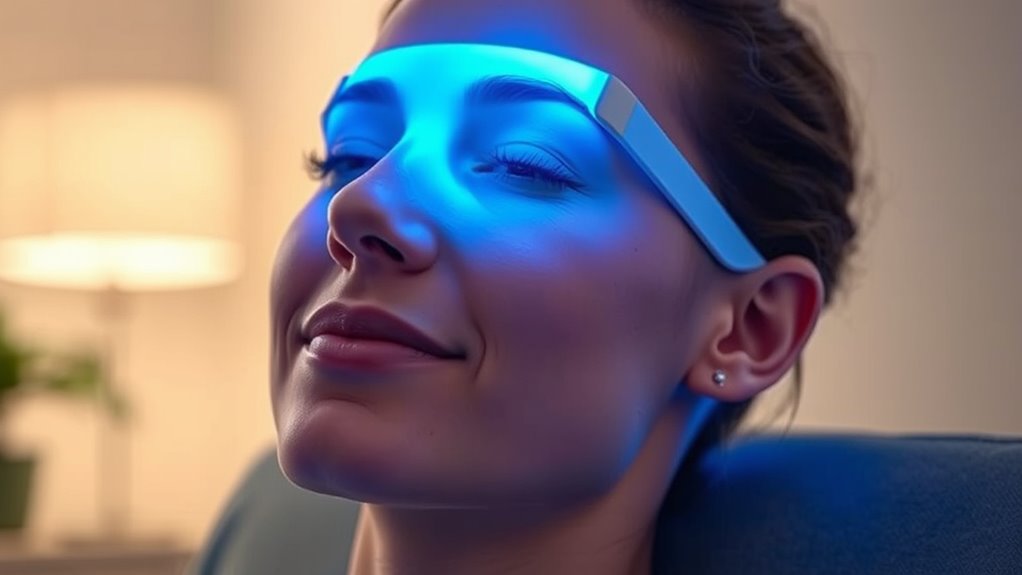
LED light therapy can offer significant relief from seasonal depression, but its effectiveness depends on factors like light intensity and duration. You should also be aware of potential side effects, such as eye strain or headaches, even though they’re usually mild. Understanding these benefits and limitations helps you make informed decisions about using this treatment. Additionally, proper light exposure timing is crucial to maximize benefits and minimize any adverse effects.
Effectiveness Factors
While LED light therapy shows promise for treating Seasonal Affective Disorder, its effectiveness can vary based on several factors. One key element is light intensity; higher lumens generally deliver more reliable results. The duration and timing of exposure also matter—consistent daily sessions tend to be more effective. Additionally, device portability influences your convenience and adherence; portable devices make it easier to fit therapy into your routine. Keep in mind that not all devices emit the same quality or intensity of light, which can impact outcomes. Factors like proper positioning during sessions and individual response also play roles. Studies suggest that the light spectrum of the device can significantly affect its therapeutic efficiency. Understanding these elements helps you optimize your treatment and increases the likelihood of experiencing the potential benefits of LED light therapy.
Side Effect Risks
Although LED light therapy is generally considered safe, it does carry some side effect risks you should be aware of. Skin sensitivity is a common concern; prolonged exposure might cause irritation or redness, especially if your skin is sensitive. It’s important to follow recommended treatment times and consult a professional if you notice discomfort. Eye safety is another critical factor; staring directly into bright LED lights can strain your eyes or cause discomfort. Using proper eye protection, like goggles, minimizes this risk. While serious side effects are rare, it’s essential to monitor how your body responds and report any adverse reactions to your healthcare provider. Being informed helps ensure you experience the benefits of LED therapy safely, without unnecessary risks. Additionally, understanding potential health impacts can help you make informed decisions about your treatment plan.
Integrating LED Therapy Into a Holistic Approach to Managing SAD
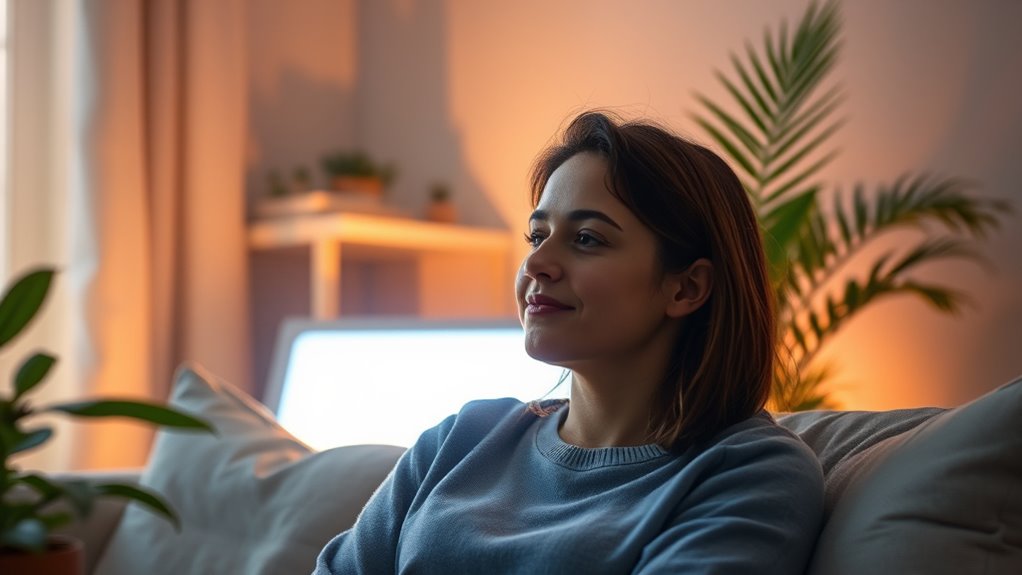
Integrating LED therapy into a holistic approach enhances your efforts to manage Seasonal Affective Disorder effectively. By combining light therapy with lifestyle adjustments, you strengthen the mind-body connection essential for mood regulation. This approach encourages you to:
- Incorporate regular outdoor activities to boost natural light exposure
- Maintain consistent sleep schedules to support your circadian rhythm
- Practice stress-reducing techniques like meditation or yoga
These strategies complement LED therapy, creating a balanced plan that addresses physical, emotional, and mental well-being. By making mindful lifestyle choices, you optimize the benefits of light therapy and foster long-term resilience. This all-encompassing approach helps you stay proactive in managing SAD, empowering you to navigate the winter months with greater stability and improved mood.
Frequently Asked Questions
Are There Any Side Effects Associated With LED Light Therapy?
You might wonder if there are side effects from LED light therapy. While generally safe, some people experience light sensitivity or skin irritation, especially if they have sensitive skin or are exposed too closely or for too long. It’s important to follow guidelines and consult a healthcare professional if you notice any adverse reactions. Usually, these side effects are mild and temporary, but paying attention to your body’s response is key.
How Long Does It Typically Take to Notice Improvements?
Ever wonder how soon you might see results from light therapy? Usually, you can expect to notice symptom improvement within one to two weeks, but timing expectations vary. Some people feel better after just a few sessions, while others need a month. Consistency is key—regular use maximizes the chances of a positive mood change. Are you ready to give it a try and see how your mood improves?
Can LED Therapy Be Combined With Medication or Therapy?
Combining treatments like LED therapy with medication or therapy can enhance your overall approach to managing mood disorders. Therapy integration allows you to address different aspects of your condition simultaneously, potentially leading to better results. You should always consult your healthcare provider to guarantee safe and effective therapy integration, as combining treatments can complement each other and provide a more thorough strategy for improving your mood and well-being.
Is LED Therapy Effective for All Ages and Severity Levels?
Oh, surely LED therapy is a magic wand for everyone, right? Not quite. You’ll find it works differently across age groups and severity levels. Younger folks with mild symptoms might see quick mood boosts, but older adults or those with severe depression may need additional treatments. So, don’t expect one-size-fits-all solutions—LED therapy’s effectiveness varies, making personalized approaches essential for true mood improvement.
What Should I Do if LED Therapy Doesn’t Work for Me?
If LED therapy doesn’t work for you, don’t give up. You should explore alternative treatments like medication, counseling, or lifestyle changes. Talk to your healthcare provider about therapy adjustments or combining different approaches to find what works best. Remember, everyone responds differently, so being open to trying new options can help improve your mood and overall well-being. Stay proactive and work closely with your doctor to find the right solution.
Conclusion
Embracing LED therapy could be your secret weapon against the winter blues, transforming your mood with a simple, powerful glow. As science continues to illuminate its potential, you hold the key to harnessing this technology safely and effectively. With consistent use, you might just reveal a brighter, more vibrant version of yourself—outshining even the sunniest days. Don’t underestimate the power of light; it’s your beacon toward hope and well-being.
